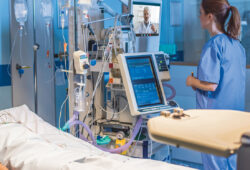The COVID-19 pandemic shook health systems across the country to their core. Not only were hospitals struggling to keep up with demand, but people were fearful of visiting their local hospital or doctor’s office for routine care. Countless HealthTrust member organizations rose to the occasion by offering quick, creative and cutting-edge solutions to give patients what they needed right in their home environment.
From at-home monitoring to free meals, these member facilities exceeded expectations during the pandemic, meeting patients where they are. Here are some examples.
Early adoption of drive-thru testing
Although Michigan’s total number of COVID-19 cases isn’t currently the highest in the country, the state did see an early surge, making it a pandemic hot spot in late March and early April. At one point, the Great Lakes state had the third-highest number of deaths in the nation, second only to New York and New Jersey.
While drive-thru testing has become ubiquitous, Mercy Health—a multi-hospital system serving Western Michigan—was an early adopter of the concept. It began offering drive-thru COVID-19 testing at the very beginning of the pandemic. The testing, which was available in Grand Rapids and Muskegon, provided test results within 24 hours for community members who were symptomatic but didn’t require hospitalization.
In June, Mercy Health also offered free COVID-19 testing for 1,000 people in the Roosevelt Park neighborhood of Grand Rapids.
Innovative at-home monitoring
St. Luke’s University Health Network in Philadelphia catered to its community by becoming one of the first organizations in the world to remotely monitor COVID-19 patients. The health system uses a tetherless, wearable device called the Masimo SafetyNet to track the respiration rate and blood oxygen saturation of COVID-19 patients in the hospital, as well as those who are at home with mild cases that don’t require hospitalization.
Data from the device—along with answers to questions like, “What is your temperature?” and “Are you having trouble breathing?”—is sent to healthcare providers twice a day.
St. Luke’s also uses the device, which connects to a smartphone through Bluetooth, to track the health of employees who are exposed to COVID-19, protecting employees and the community at large.
Food & beds for vulnerable patients
The last thing people want to think about when they’re discharged from the hospital are household tasks like cooking and cleaning. CentraState Medical Center in New Jersey realized this, which is why the health system took it upon itself to provide free meals to COVID-19 patients who were cleared to go home.
The initiative, which launched in May, is targeted at the most vulnerable COVID-19 patients, including people who are elderly, live alone, are without transportation to the grocery store and are struggling financially. Patients are given a package with two to three days’ worth of meals, as well as nonperishable snacks and gift cards to local restaurants.
St. Luke’s also extended its commitment to the community by supporting the local homeless population. The health system teamed up with health bureaus, faith-based organizations and other hospitals to arrange for homeless residents with COVID-19 who needed to quarantine to stay at hotels free of cost. This not only gave sick patients a warm bed, but also prevented community spread of the novel coronavirus.
St. Luke’s staff members routinely checked on homeless patients, and meals were provided through Meals on Wheels.
Remote concern for cancer patients
Countless people are susceptible to contracting a severe case of COVID-19, from those with heart disease to those with diabetes. One of the most high-risk populations are people with cancer who are immunosuppressed due to chemotherapy. A mobile health researcher and an oncologist at Stephenson Cancer Center in Oklahoma City teamed up to create an app designed specifically to help monitor cancer patients for symptoms of the novel coronavirus.
The app prompts patients with a series of questions every morning (such as whether they’re experiencing a cough or a fever). If any of the answers indicate the patient could be experiencing symptoms of COVID-19, testing is recommended. Patients can also use the app to communicate with nurses, eliminating the need for an unnecessary hospital visit. To start, the program enrolled 500 cancer patients.
Share Email COVID-19, Q4 2020, Telehealth




